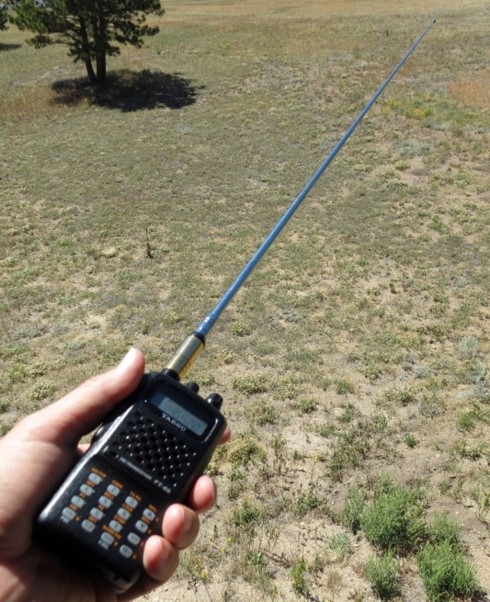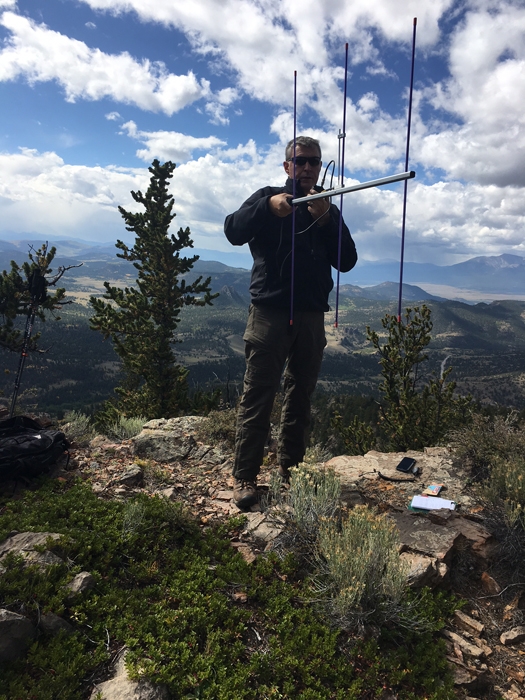On the Air Blog | Magazine | Podcast | Facebook | Join/Renew
Find A High Spot For VHF
30 January 2020
by Bob Witte, KØNR
[email protected]
New hams often start out with a handheld VHF transceiver, low-cost radios that come with a power source and compact antenna, commonly known as a “rubber duck.” On its own, a typical handheld radio doesn’t usually transmit too far, which is why we use repeaters to extend the range. Repeaters are normally located on a high spot, perhaps on top of a mountain or a tall building, to provide the best radio horizon. Radio enthusiasts refer to this as having Height Above Average Terrain.

Photo 1: A handheld transceiver with a 2-meter range-extending antenna.
Reach the Heights
We can do the same thing with our own handheld radios — operate from a high spot. Here in Colorado, this makes me think about hiking or driving to the top of a mountain and making radio contacts. But the same idea applies to any means of gaining some height, whether it’s a high mountain, a smaller hill, or a tall building or other manmade structure.
On flat terrain, a low-power VHF handheld might be useful for radio contacts to stations a few miles away. If you get on top of a mountain, that range improves dramatically. For example, from the top of Pikes Peak, handheld radio range extends out to 100 miles! Every year, hams visit my state to do just that. Typically, they drive to the summit of Pikes and then see what long-distance radio contacts they can make, using their handheld radio or their mobile rig.
Make a Call
What frequency should you call on? Well, first try the 2-meter FM National Simplex Calling Frequency, 146.52 MHz. That’s the default place to make a simplex call — a call in which both operators take turns communicating directly on the same frequency (without a repeater or other device between them). Say something like “CQ 2 meters, this is K Ø A B C on the top of Pikes Peak.” It’s important to remember not to be a channel hog on the calling frequency. In some locations, 146.52 MHz is monitored by many hams who may get annoyed if you tie up the frequency for very long. Once you’ve established a contact on the calling frequency, it’s a good idea to move that contact to another agreed-upon frequency. (In other areas, the calling frequency is dead quiet and you may not be able to raise anyone.) Another option is to make a call on a repeater — especially a distant one. The idea is to reach out and see who you can contact.
Get a Better Antenna
As a general rule, improving the antenna on your station is a great way to increase its performance, because a better antenna improves both transmit and receive. The standard rubber duck antenna that came with your radio is certainly compact and convenient, but it does not radiate very well. Antennas with half-wave radiators are much more effective, such as the MFJ-1714 antenna shown in Photo 1. The antenna has a matching device built into the base of the antenna that maximizes the transfer of power from the radio to the antenna (also known as impedance matching). The antenna is available with either BNC or SMA connector, so get the one that matches your radio. Take care not to stress the antenna connector on your radio with the longer antenna.
The next step up is to use a small Yagi antenna. For example, Photo 2 shows a three-element Yagi antenna from Arrow Antenna (Model 146-3BP). This antenna provides additional gain with respect to the half-wave, which produces an even stronger signal and better receive capability.

Photo 2: Bob, KØNR, using a three-element Yagi antenna on a summit.
There are several different range-extending antennas on the market to choose from. Online reviews from other hams are easy to find when comparing options. Or consider building a simple ground-plane antenna (“Extend Your Handheld’s Range with a Simple Ground-Plane Antenna” On the Air magazine Jan/Feb 2020, www.arrl.org/ota).
The Summits on the Air Program
Summits on the Air (SOTA, https://www.sota.org.uk) is a fun awards program for mountaintop operating. Most of the US states have designated SOTA summits, even states that you might think are too flat. The SOTA Atlas (SOTLAS, https://sotl.as/) is an online map that allows you to quickly zoom in and see where summits are located.
Radio operators that make radio contacts from these summits are called activators, while other hams they contact down below are called chasers. Activators and chasers earn points with each radio operation, which accumulate to qualify for awards. It’s a fun way to keep track of your radio activity.
Get Outside, Play Radio
Whether you have Pikes Peak in your back yard or you are in the middle of Iowa, it’s fun to find a high spot and see what you can do on VHF. You may be surprised how far your little handheld radio can communicate.
More VHF operating ideas and tips can be found in my book: VHF, Summits and More: Having Fun With Ham Radio, available from the ARRL store at www.arrl.org/shop/VHF-Summits-and-More.
ARRL Resources for Learning More
“Repeaters — Your Friends in High Places” On the Air magazine Jan/Feb 2020, www.arrl.org/ota
The ARRL Repeater Directory® (produced annually) http://www.arrl.org/shop/The-ARRL-Repeater-Directory
Share Your Stories
Whether you are new, an expert or somewhere in between we invite you to take part in the conversation. Share your stories and experiences by emailing [email protected].
Click here to return to the On the Air Blog main page.
News & Features >> On the Air Magazine >> On the Air Blog >> Find A High Spot For VHF













